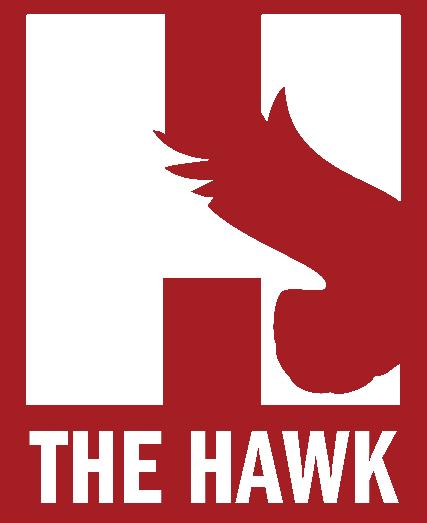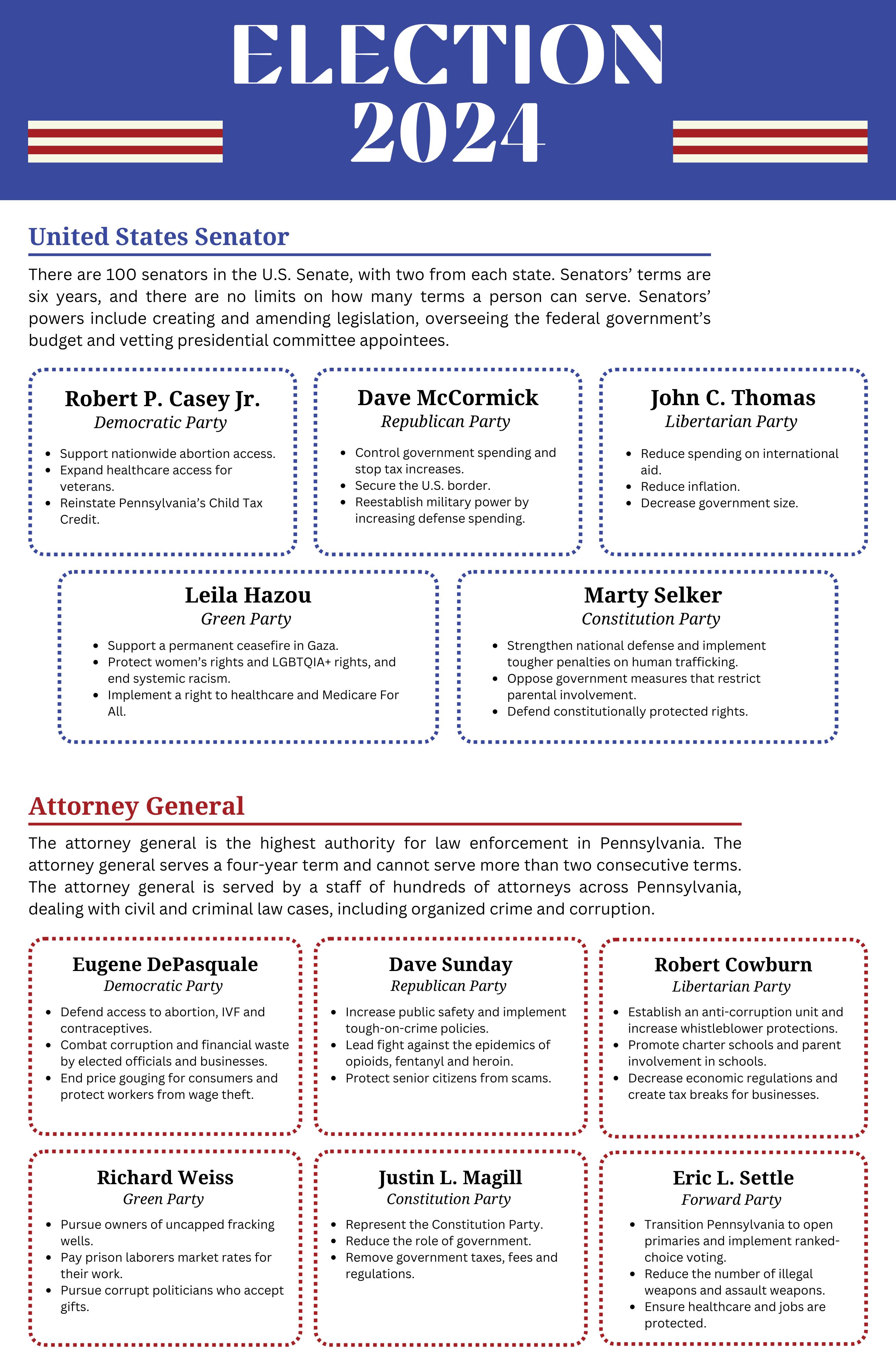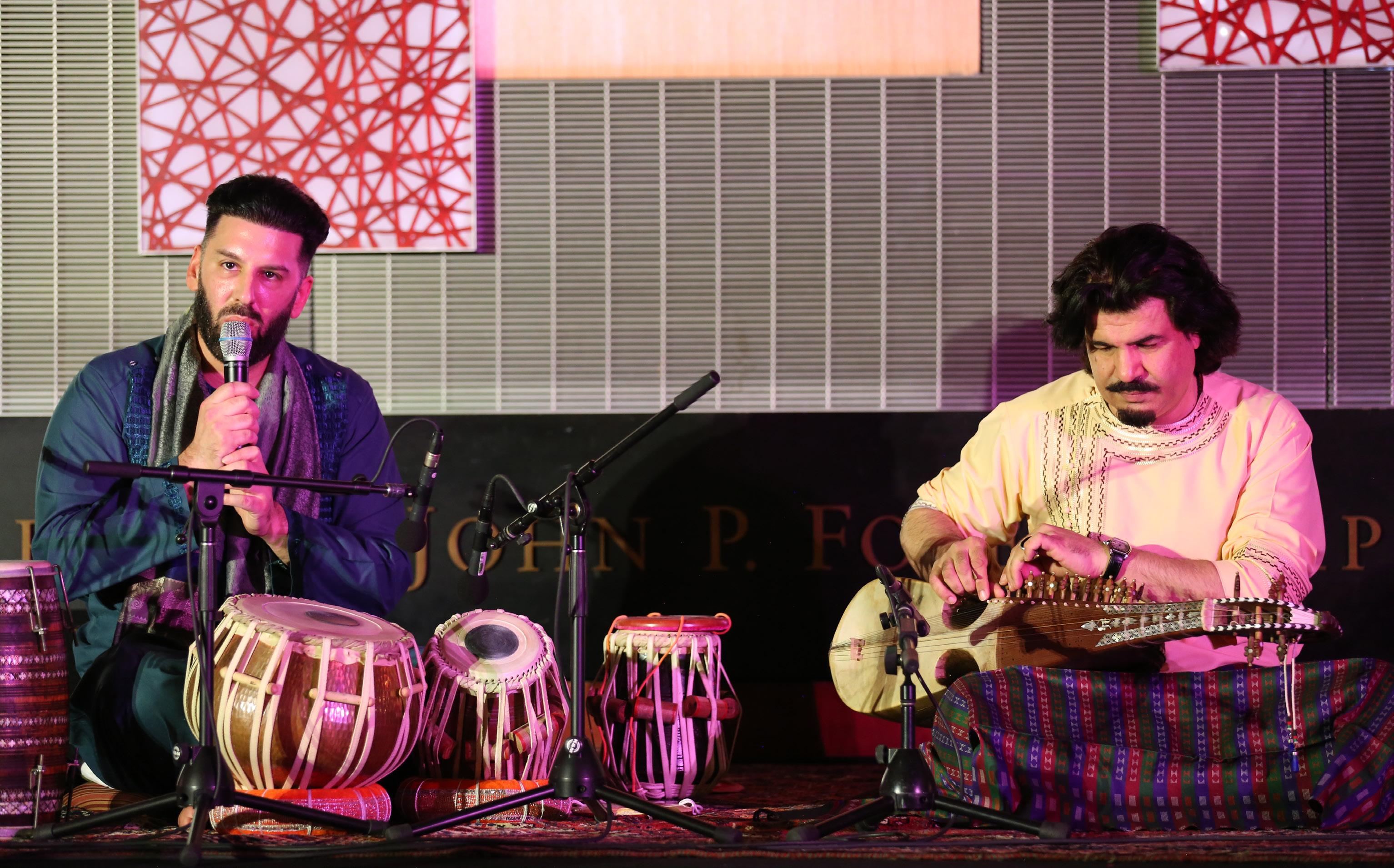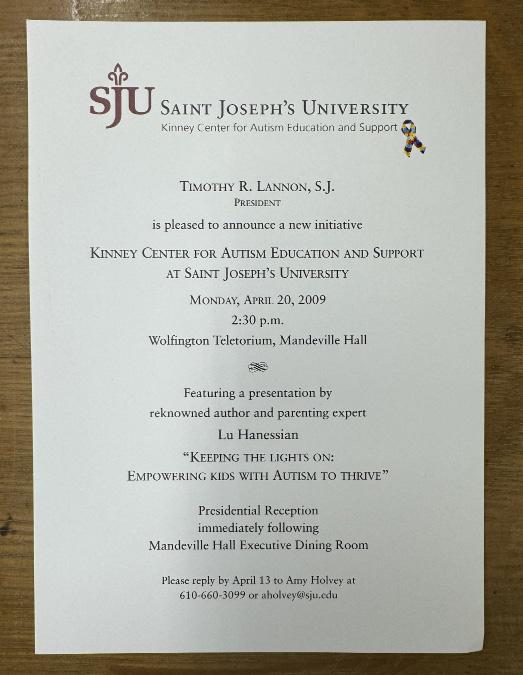




Data for the graphs below were collected from members of the St. Joe’s community. The survey was conducted by students in the Media, Politics and the Election course, and The Hawk reporters. Data collectors used anonymous paper-and-pencil surveys. Additional data came from a link to an online survey on The Hawk’s Instagram and Facebook pages. A total of 119 people responded to the survey conducted from Oct. 24–28. All respondents answered questions one and two, and 118 respondents answered question three. Questions were modeled on the Pew Research Center polls. For question one, respondents were able to select up to three issues.
are the most important issues to you in the Nov. 5 election?
How are you voting in the Nov. 5 election?
In which state are you registered to vote?

It feels like every election is labeled as “the most important in our lifetimes,” and 2024 is certainly no exception to this. However, the redundancy of these disclaimers should not overshadow just how high the stakes are on the ballot this year. It’s incumbent on each participant in this election to realize just how impactful their voice is.
The vast majority of St. Joe’s community members are eligible to vote in Pennsylvania, and — after weeks of tireless voter registration efforts — they’ll make their voices heard next week. Though there is a litany of competitive races up and down the ballot, it’s unsurprising the presidential election gets the most spotlight. With
Pennsylvania as one of the most coveted states on the map, both campaigns have made the commonwealth central to their electoral strategies. Polls continue to show a dead heat, giving voters and the St. Joe’s community an opportunity to tip the scales.
As much of an impact as St. Joe’s community members will have on the national level this year, their votes will arguably be more impactful on the state and local levels. No matter who the next president is, the balance of the U.S. Congress will determine their legislative success, or lack thereof. With an evenly split state legislature, the outcome of this election will have a profound impact on Pennsylvania’s near and long-term future.
Is political violence America’s new reality? In just three months, there have been two assassination attempts on former President Donald Trump. Additionally, in 2022, we saw former Speaker Nancy Pelosi’s husband, Paul, get attacked in his own home, in which he sustained serious injuries while being beaten with a hammer. Many Americans are scared about this seemingly sudden turn in our country. The public’s heightened concern has been confirmed by a recent Reuters study, which reports that since the January 6, 2021 attack on the U.S. Capitol, which directly and indirectly took the lives of
seven individuals, 213 cases of political violence have been committed. Of these, 76 were physical assaults with 18 lives lost. Democracy cannot and will not survive if we believe that reaching for our guns or raising our fists in violence are the only ways to achieve our desired political outcomes. As a Sister Carol Coston Fellow at NETWORK Advocates for Catholic Social Justice and a Gen Z voter, I say that political violence is not only a threat to democracy, but a direct attack on human dignity. Political violence prevents us from working in solidarity to honor the dignity of human lives. We must promote non-violence
Since the last presidential election, it’s become clear the democratic process isn’t a given. It’s a fragile tradition that depends on voters and officeholders exercising their power in a civil and responsible manner. The uptick in political violence in recent years — with attempts on the lives of political figures and an assault on the peaceful transfer of power — is a reminder that as much as civic participation is a privilege and a responsibility, it is also a power, and one we must use responsibly.
and unity if we are to move toward a future of justice and mercy.
— Baylee Fingerhut ’26

JOSEPH POWERS Guest Columnist

On the evening of Nov. 5, many Americans will settle in to learn the identity of the next U.S. president. Here are a few things to watch if you want an early read of the election.
We don’t have one national election in this country. We have 51 separate races, each with its own rules. For example, we no longer have Election Day — we have Election Month because of a variety of early voting methods and counting rules. States also get to set their own voting hours. Some close polling places at 6 p.m., while others go to 9 p.m.
So, what to watch? As many of us know, there are seven presumed swing states, but I’m watching Florida early in the evening. Yes, Florida is a probable Donald Trump win. But
Florida is also an early closer (ending at 7 p.m.), and they have early votes counted when the polls close. In 2016, some astute observers could tell things weren’t going according to script when Florida’s early voting popped up on the chyron, showing Trump running way ahead of his projected results. Another state to follow early is Georgia, also closing at 7 p.m., and a true swing state.
What about Pennsylvania, St. Joe’s host state and perhaps the most important purple state — with a near-equal number of Democrats and Republicans — in this election? Many believe we will have to wait until Saturday morning, like we did in 2016, to learn who won here. I’m not buying another four-day delay. Pennsylvania counties have had four years of experience handling early votes, and some, like Allegheny, have greatly upgraded their equipment. In fact, in the spring, races were effectively
decided when some Allegheny results were called at about 8:30 p.m. It won’t be that fast this time, but there won’t be another four-day delay either. What else to watch? Bucks (big and a swing county), Lehigh Valley (a big, purple county with many Hispanic voters who could sway the results) and Dauphin/ Cumberland (the fastest-growing county, and one in transition to Democratic).
Joseph Powers is an adjunct professor of political science.



TRIMBLE ’26


Project 2025’s reforms threaten the progress toward equality for the LGBTQIA+ community.
Framing queer identities as a threat to society, Project 2025 fuels and supports the discrimination of LGBTQ+ individuals through harmful rhetoric and policy initiatives that serve as major setbacks for equality.
The most disturbing and baseless claim put forth by Project 2025 is that the “propagation of transgender ideology” equates to pornography and the sexualization of children. According to
Project 2025, all librarians and educators who use materials with this “pornography” should be “classed as registered sex offenders,” further promoting the false belief that a transgender identity is synonymous with explicit content.
This rhetoric promulgates the false narrative that transgender individuals are dangerous, thus subjecting them to discrimination, social stigma and violence based on lies. Project 2025’s call to remove transgender identities from school settings is extremely harmful to LGBTQ+ youth, many of whom already face mental health challenges due to bullying and rejection by their peers. Schools with inclusive curriculums provide a safe environment for students of all identities to express themselves.

As the current election season unfolds, it feels like we’re caught in a surreal déjà vu. As a society, we’ve made significant advances in many areas for women’s rights, but as soon as we thought the fight for equality was almost over, women’s reproductive rights are at risk once again. A study from the Rape, Abuse & Incest National Network shows 13% of all college students experience rape or sexual assault, including 26.4% of undergraduate women and 9.7% of graduate women. The ongoing issue of sexual assault is a major problem on its own, and many women feel scared to pursue legal action after experiencing sexual assault, because of the risk of not being believed. These struggles
are compounded by the possibilities of women’s reproductive rights being stripped away and losing bodily autonomy. Philadelphia is full of artwork that portrays the emotional overload a woman can experience due to sexual assault. At the Philadelphia Museum of Art, there is a piece called “Etant donnés…” by Marcel Duchamp that can be analyzed in terms of sexual violence against women. Duchamp’s “Étant donnés…” is a three-dimensional environmental tableau like a wooden door, and looking through two holes in the door shows an image of a naked woman lying on dead shrubbery. In my art classes at St. Joe’s, we have discussed interpretations of Duchamp’s works that reflect the complexities of gender dynamics, including themes of sexual agency and objectification.
Viewers have described Duchamp’s artwork as “the strangest work of art in any museum,” which fits the feeling of this election. However, it truly encapsulates
Ignoring the necessity for inclusion based on an incorrect characterization of transgender identities sets American society decades behind in the progress toward equality.
Project 2025’s broader calls to eliminate the terms “sexual orientation” and “gender identity” from federal legislation demonstrates the plan’s overall stance on LGBTQ+ rights.
In 2020, the Supreme Court ruled in Bostock v. Clayton County that LGBTQ+ individuals cannot be fired based on their sexual orientation or gender identity, thus affirming the basic right for queer individuals to exist without workplace discrimination.
Removing specific references to “sexual orientation” and “gender identity”
in federal legislation makes such discrimination harder to challenge under federal law, opening up the possibility for discrimination throughout employment, housing, healthcare and education.
Project 2025’s rhetoric, which vilifies LGBTQ+ individuals for seeking equal protection under the law and representation in society, deepens divisions within our nation. Instead of championing Project 2025’s discriminatory policies, we should be working towards a future in which all people, regardless of how they identify, have equal opportunity to succeed and thrive in the United States.
the uncertainty many women experience regarding future decisions about their own bodies.
Artwork such as this piece and many others play such an essential role in our society because they can portray messages in a manner that goes beyond spoken or written words. These types of
compositions represent issues with raw emotion, which allows them to resonate with their audiences. The pieces express a genuine concern for our society, pushing us to educate ourselves and one another and to make a positive impact on the upcoming election.

action and the future of our planet
‘What can you do?’

As the great orator Post Malone once said, “Life, it goes on, what can you do?” Many of us, myself included, have fallen into this mindset with regard to climate change. In the upcoming election, some may feel their vote can make a difference on this issue, while others may not. Voting is just one way to make an impact, however small. Other actions — like consuming less, walking more and conserving water — also count. Everything is connected in one way or another, so what you do
matters, even if it feels like it doesn’t. While responding to climate change is necessary, finding solutions most of us can agree on is challenging. Under the BidenHarris administration, several policies have been passed or proposed with the aim of reducing carbon emissions, and many of them focus on how we source and distribute energy. Trump’s campaign, on the other hand, has pledged to withdraw from the Paris Agreement, an international treaty to reduce greenhouse gas emissions, if re-elected.
For voters, a multitude of factors can influence their decision — some concrete, like policy positions, and others more abstract, like candidate vibes. While climate change may not be the most pressing issue, with approximately
37% of all voters saying it is very important compared to 81% who say the same about the economy, the issue is important nonetheless. This gap reflects our present bias, the tendency to make decisions based on immediate outcomes rather than future ones, making today’s economy seem more pressing than “slight temperature increases.” But even modest elevations in global temperatures are already causing significant consequences, including the emergence of more potent storms, persistent wildfires and the loss of biodiversity as ecosystems struggle to adapt.
Respectfully, science does not care what we believe. The world is changing, and we must change with it. Let us be mindful of how our actions, such as
voting, can impact our future. To answer Malone’s question from earlier: What you can do is vote — and even plant a tree or two.

JARED NACHIMSON ’27 Guest Columnist
are Pennsylvanian politics this way?”


It’s fair to say that Pennsylvania, right now, is getting its generous share of election coverage. Pollsters and politicians across the commonwealth are constantly at odds trying to anticipate the electoral results of this battleground state. It almost seems impossible to predict but, likewise, impossible to ignore. In past elections, Pennsylvania’s results have swayed, with neither party really gaining political dominance over the other. Currently, there haven’t been answers as to which party will win the state. But, as a native Pennsylvanian, I keep asking myself: “Why
One factor affecting Pennsylvanian politics is the demographic change. Beyond Philadelphia, the state’s largest city, Pennsylvania has experienced a growth of migrants to small towns in search of work opportunities. Their presence in the Rust Belt, an area throughout the Midwestern U.S. nicknamed for its aging infrastructure and industry, has tilted some long-standing Western Pennsylvanian voters towards a more cautionary and conservative stance. This conservative realignment, with the addition of new migrant voters, has created a political vacuum for candidates to campaign in.
Suburban voters are another crucial aspect of Pennsylvania politics, and their
malleable votes are incredibly sought after by political candidates vying for their support. However, not all suburbs are impartial. Recently, suburbs in Delaware, Montgomery and Chester counties have become more left-leaning, in part due to their proximity to a reliable Democratic bastion like Philadelphia, compared to the slightly right-leaning, but still swing northeastern and western counties of Northampton and Erie, respectively. Regardless, suburban votes have been frantically fought over during this election cycle, and for a good reason: Their votes might possibly be the deciding factor in this upcoming election.
You may be asking yourself, “What does this mean for me?” It means whether you’re
a resident of Pennsylvania or merely a visitor in this beautifully complicated state, the deciding votes in the current national, state and local elections could make a significant impact in swaying the balance of power in government. So, make your plan to vote in this election.


What
BAYLEIGH
CALHOUN ’25
Guest Columnist

John Adams is credited with stating that the U.S. must be “an empire of laws, and not of men.”
This principle, the rule of law, has served as the foundation for American political philosophy and constitutional democracy since the nation’s founding. It asserts that all citizens, including lawmakers and government leaders, are accountable to the law, ensuring a system where powers are separated and cannot be exercised arbitrarily by those in authority.
Former President Donald Trump has repeatedly and persistently undermined the rule of law since his loss in the 2020 presidential election. By groundlessly challenging the election’s results in court and insisting the election was stolen, Trump has eroded faith in democracy and discredited the legitimacy of the electoral process. His actions surrounding the Jan. 6, 2021 insurrection on the U.S. Capitol and his failure to uphold constitutional procedures for a peaceful transfer of power further prove his disregard for the rule of law. Additionally, by claiming presidential immunity for his role in the insurrection, he’s allowed the Supreme
Court to grant presidents a degree of criminal immunity for any official acts, contradicting the rule of law and denying the people’s ability to hold leadership accountable.
Democracy cannot exist without the rule of law protecting citizens’ rights, and Trump’s persistent defiance of democratic norms threatens its preeminence. This election is unique in that it is not simply a choice between a Republican or Democratic candidate. It is a choice between embracing or rejecting American values. Regardless of party affiliation, I urge you to vote for Vice President Kamala Harris in the upcoming election to ensure our country’s future and prevent the further erosion of our democracy. As members of the St. Joe’s community, we are lucky enough to live and learn in Philadelphia, the birthplace of the U.S. Constitution. We must use our voices and our votes to protect the ideals established by the Founding Fathers in our city so many years ago. Vote Harris.
Bayleigh Calhoun ’25 is the president of the SJU College Democrats.
Who has been able to support you?
GIANNA LONGO ’26 Guest Columnist

The election is right around the corner, and it’s getting down to the wire to decide which candidate will receive your vote. As the president of SJU College Republicans here on Hawk Hill, instead of convincing you why you should vote Republican, I want to appeal to those who are unsure if they should participate in this election because they do not know which way to lean. Being a Republican on this campus is met with very different responses. Most of the time, I can converse with other students about their political opinions, but sometimes others will cover up or take down our flyers. This election is unique; unlike other elections, we can now look at the candidates’ previous history in office. In comparing the information from when former President Donald Trump was in office to the past four years for Vice President Kamala Harris, ask: Who has been able to support you and your family the most? Before I could vote, my family was voting for Trump because, at that time (and even now), his policies benefited them more than those Joe Biden planned to implement, or even Hillary Clinton the
first go-around.
Now that I can finally vote and understand how a candidate’s policies will affect me in the future, that is what I take into consideration. I believe you do not have to be head over heels for a politician or agree with every point they make. When it comes down to it, Trump and Harris are very different candidates. This makes the decision very polarizing. When researching the candidates, it is essential to look at the most critical issues to their potential administration. I believe the only person who should decide who you vote for in this upcoming election is yourself, based on your own research. I try to avoid what other people — like influencers, celebrities and, sometimes, friends — say, because doing your own research is beneficial. So, let me leave you with this: Which candidate is going to secure a future for you now, for you after college and for our country as a whole?
Gianna Longo ’26 is the president of the SJU College Republicans.



‘We’re the first but not the last’
Since he learned to play the tabla — hand drums from Central and South Asia — at seven years old, Salar Nader has performed throughout the world, making his St. Joe’s debut alongside fellow Afghan musician Homayoun Sakhi in Cardinal Foley Campus Center Oct. 23. However, performances involving Nader’s tabla and Sakhi’s rubab — a lute-like string instrument — are banned in Nader and Sakhi’s ancestral home.
The musical journey
Sakhi, born in Kabul, Afghanistan, learned to play the rubab, which is the country’s national instrument, from his father. In 1992, Sakhi and his family fled Afghanistan and moved to Pakistan following the Soviet Union’s invasion of the country, where he gained recognition for his rubab skills. Since 2001, he has lived in the U.S., performing and teaching rubab.
Sakhi said although he grew up hearing the rubab, he knew he wanted to play it after he woke up from a dream where he heard the rubab from the sky.
“The instrument chose me,” Sakhi said. The sound of the rubab, Sakhi said, is one of the many reasons he loves the instrument dearly.
“It’s the sound of Afghanistan,” Sakhi said. “And that’s why I play this instrument. It’s so special for me.”
Nader was born in Germany, the country to which his parents fled after the Soviet invasion of Afghanistan. During this decade-long conflict, known also as the Russian-Afghan war, Nader’s parents eventually settled in the San Francisco Bay Area. Nader remembers walking into his first tabla class in 1985, at just seven years old, and began his tutelage under five-time Grammy Award-winning tabla artist Ustad Zakir Hussain. Nader was the only child in the class, with the next-youngest students being in their twenties and thirties.
“I’d been playing the tabla within
family, household gatherings, fundraising concerts for Afghanistan, playing folk and traditional rhythms as a toddler,” Nader said.
“But it was time to take the next steps on my rhythmic journey and musical journey.”
Throughout the years, Nader has collaborated with musicians across the globe and promoted Afghan culture on large stages, making his debut as an on-stage musician in “The Kite Runner” on Broadway shortly after the Taliban re-took control in Afghanistan. During his tabla journey, he met Sakhi, who he has partnered with for nearly 30 years.
“Our music is rooted in spirituality, and you feel it when we get together and get on stage,” Nader said. “It really is, not to sound cliché, food for the soul.”
Bans and responses
Since the Taliban regained control of Afghanistan in August 2021, the country has been under a music and creative arts ban, with instruments like the tabla destroyed in bonfires.
Amber Abbas, Ph.D., associate professor of history and director of the Nealis Program in Asian Studies who coordinated the event, described this ban as “so deeply painful.”
“I grew up in Muslim culture that was filled with music, filled with poetry,” Abbas said. “Throughout Muslim societies, we have very rich musical traditions. The idea that the Taliban is trying to mark a firm boundary between what is ‘Muslim’ and what is ‘art’ is just so blind to the richness of the art that has been produced in Muslim societies.”
In light of bans and violence, Nader and Sakhi strive to share the beauty of Afghan culture, hoping their music brings light in the darkness.
“In this world of war and constant crises and battles, we need to cool the temperature down and share some positivity,” Nader said. “And that’s what we do. We try to give Afghanistan its positive image. Our message within our music is just love, compassion, positivity. And that’s what music is supposed to do. It’s supposed to uplift.”
The uplifting spirit of Nader and Sakhi’s music could be felt throughout Cardinal Foley, where people got out of their seats to dance along with the melody and children jumped and raised their hands when Nader asked who in the audience was Afghan.
“The impact was seen just through the audience here; everyone clapping along in unison,” Nader said. “And you had people of all diversities, all ethnic cultures, belief systems. But we were all one in that moment. And there was no ‘Oh this is them, and this is us.’ It was almost like we were one family.”
Changing perceptions
Afghanistan, Nader said, has a rich musical history, with instrumental music rooted in Sufism, a segment within Islam centered on mysticism, and its traditions. A goal of performing, Nader said, is educating audiences on the rich history of Afghan music.
“I was in Louisville, Kentucky once, and people were like, ‘Wait, you have music in Afghanistan? Wow, really? Well, what is it?’” Nader said. “And so part of what we do is we educate. It’s one thing to go on stage and play a rocking concert, but it’s another thing to educate our audiences and invite them into our musical traditions.”
Performing, however, is not always void of stereotyping, a result of negative portrayals of Afghanistan and Afghan people in media coverage. Nader said people sometimes “judge a book by its cover” during concerts and make assumptions about him while he’s wearing traditional Afghan attire.
In one instance, Nader was told secondhand that a family said he looked like a Taliban member. Then, after listening to him perform, the father of the family approached Nader and said he expected Nader to come onstage and chant “something like, ‘Death to America.’”
“My heart jumped,” Nader said. “Our sound engineer immediately turned around and [was] like, ‘Dude, what?’ And so he was
like, ‘Sorry, I just couldn’t help [it], but my family was in tears watching you perform. You took a solo, and then you spoke to us, and you spoke about the rhythm, and our perception literally changed about Afghanistan.’”
Nader said it’s in those moments where he knows that performing is what he’s meant to do.
“That’s why I’m going to continue to be doing what I do until the last breath,” Nader said.
Justice and dialogue Abbas said performances like Nader and Sakhi’s are important to have at St. Joe’s because they highlight the importance of promoting justice in a global context.
“It’s not just about showing up in our spaces here in the United States and advocating for social justice here,” Abbas said. “It’s also maintaining an awareness of what is happening in other parts of the world, and showing up with those same intentions about working towards a more just world for all the people in it, no matter what their backgrounds or identities are.”
The importance of starting conversations about diverse cultures and promoting justice was emphasized by Nader, who also runs the Salar Nader Tabla Foundation, which provides music and arts programming for youth. Sakhi, also promoting the importance of Afghan music, founded the Rubab Academy, an online school that provides rubab classes.
“I hope through what we do, the conversations we’re starting, we’re able to open the door, to not be the first Afghan American duo that comes to St. Joseph’s, but to be who opens the door and unlocks this beautiful conversation and dialogue for many, many more artists to come,” Nader said. “There’s so many reasons why this is important, and I always say, ‘We’re the first but not the last.’”

Abby Williams ’25 began at St. Joe’s as a political science major before switching to a major in theatre and film, with a concentration in musical theatre, and a second major in art. She chose St. Joe’s because her mom is an alumna, but chose musical theatre because she’s always loved it. “I started dancing when I was three, and I wanted to still have that when I was in college,” Williams said. Williams joined the SJU Theatre Company her sophomore year and has been a part of seven productions, six as an actor and one as a member of stage crew. She stars as Mrs. Corry in the company’s production of “Mary Poppins,” which premieres Nov. 1 in Bluett Theatre.
How do you hope people on campus describe you? I would hope they say I’m nice.
What is your favorite place on campus? The [Barnes] Arboretum spot with the tea houses and the lake and little bench.
Who are your heros? My mom … My mom and I have always been very close and she’s always been very supportive of my goals and aspirations. She’s also stuck with me through and shown me unconditional love through the roughest times in my life. My battle with cancer over the summer being the
biggest one of them all - so I’m eternally grateful for her!
What’s your favorite class? Acting class.
What is your favorite role you’ve played for SJU Theatre Company? Maggie in “Lend Me a Tenor.” We had Bob Kelly as a guest director and I learned so much about myself as an actress and acting in general. He was a great person to learn from!
Favorite show you’ve ever done? My favorite show I’ve done at SJU, hands down, is “Godspell” … The cast was so close and everyone was so supportive of one another. That show really brought a lot of joy into my life when I needed it most.
What is your best trait? My loyalty.

What is something about you that might surprise other people? I am a

What do you regret during your time at St. I joined a lot of activities when I was a freshman. I kind of regret not staying in a lot of them, just because the theater company took a lot of my time, so I had to quit a lot of them. And I wish I was better with time management to stick with those things.
What do you plan to do next? I’d like to go to grad school for acting so I can at least teach at a college and have a stable job, because I know it’s hard to be stable in theater. I’d like to be a professor and then do shows on the side,

Across 1.“I’m everywhere, I’m so ___.” (Charli XCX)
4.Sabrina Carpenter’s favorite coffee drink.
6.“I’ll love you ’til the day that I die, ’til the ____ leaves my eyes.” (Billie Eilish)
7.Zach Bryan and Bruce Springsteen’s collaboration.
9.Beyonce and Miley Cyrus are “II ___ _____.”
Down
2.“He laughs at all my jokes, and he says I’m so ___.” (Olivia Rodrigo)
3.Opening track of a Taylor Swift album that shares the same name as a popular video game.
5.“Good Luck, ____!” (Chappell Roan)
8.How Hozier takes his whiskey.
10.“Yes, ___?” (Ariana Grande)
In 2009, St. Joe’s invited the community to an event to announce the future opening of the Kinney Center for Autism Education and Support.
A formal invitation, sent by then-President Timothy Lannon, S.J., shared the Kinney Center’s announcement event, featuring a lecture by Lu Hanessian, an autism advocate, parent, award-winning writer and international speaker.
The 5-by-7-inch invitation, located in the St. Joe’s Archives Collection, is printed on white cardstock and features the autism puzzle ribbon. Community members were invited to gather at 2:30 p.m. April 20, 2009, in the Wolfington Teletorium in Mandeville Hall. The invitation includes Hanessian’s presentation, titled “Keeping the Lights On: Empowering Kids with Autism to Thrive,” and notice of a presidential reception to follow.
The Kinney Center, established to increase support and awareness for individuals with autism, has continued to evolve since its opening in October 2009. Recent milestones include receiving a $2 million gift from Daniel Hilferty ’78 and his wife, Joan Hilferty, in 2021 to further expand the center’s initiatives, and opening St. Albert’s Hall, a residence hall specifically designed for St. Joe’s students with autism, in 2022.
Theresa McFalls, executive director of the Kinney Center, began working for Kinney as the inaugural director of the ASPIRE program, the university’s signature support program for St. Joe’s students with autism, when it launched in 2012. McFalls wrote in response to written questions from The Hawk that Kinney “has stayed true to its mission” since its founding.
All told, McFalls said the Kinney Center has served 1,268 families and trained 675 Kinney SCHOLARS since it began. Additionally, Camp Kinney, the center’s summer camp designed to accommodate children with autism, celebrated its 15th year this past summer.
“What sticks out most to me is that the center has been able to grow with families,” McFalls wrote. “What started as youth programming (summer camp and youth social skills) has now grown into transitional, adult, and college programming. We have also expanded our training to community partners and other universities.”

MIA MESSINA ’25
Sports Editor
St. Joe’s fans got their first look at the 2024-25 men’s basketball team when it hosted Bucknell as part of its annual autism awareness game Oct. 26.
The Hawks lost, 88-82, to the Bison, who are led by former St. Joe’s assistant coach John Griffin III, who is in his second year as head coach of his alma mater.
“I root for him every single time that he plays, except for today,” St. Joe’s head coach Billy Lange said. “And I would like to play them again next year. This is a great test for us. You know they’re going to play hard.”
There were three takeaways from the Hawks’ early test against the Bison:
Getting acclimated
The Hawks were missing sophomore guard Xzayvier Brown (thumb injury) and first-year guard Khaafiq Myers (knee injury), but St. Joe’s starting five stepped up. Each starter put up double-figures Saturday, led by Erik Reynolds II’s 24 points, followed by junior guard and Rutgers transfer Derek Simpson, who added 17. Junior forward Rasheer Fleming put up 15 points, eight rebounds, three blocks and two steals, and redshirt first-year guard Dasear Haskins (14 points) and fifth-year center transfer Justice Ajogbor (12 points) made the most of their minutes.
St. Joe’s showed depth with two players out but needed to find consistency as the newest Hawks continue to settle in. St. Joe’s received zero points from its bench, which was comprised of sophomores Anthony Finkley and Shawn Simmons II and first-years Steven Solano and Mekai Johnson.
“That’s a lot of minutes for Derek, and we needed to do it with [Brown] out,” Lange said of Simpson’s 35 minutes of playing time. “I thought if anybody looked a little
bit physically fatigued, it was probably him. I thought he did a lot of good things. I think he has things he’s got to work on. It was great to get Dasear out there, after a redshirt year. I thought he got more comfortable as the game went on. Mekai is solid and smart. Steven’s going to keep having to get better. I think we have to find a way to keep him on the floor more.”
Lacking on defense
Bucknell shot 44.6% from the field, 42.3% from long range and found its way to the free-throw line 34 times. While St. Joe’s held off the Bison a little more in the second half, these numbers raise a few alarms regarding the Hawks’ defense going forward.
“When you have good players and good guys, which we have, it often comes down to the consistency of the things that are so simple people don’t think they’re important,” Lange said. “On the defensive end, just one-on-one, keeping the guy in front of you, showing your hands to the officials. There were a ton of times we put them on a foul line for no reason. Rebounding, boxing out and going and getting a rebound, we did OK, but not as well as we would want to do. Communication. These are simple things.”
St. Joe’s finished with 23 defensive rebounds, including seven from Haskins. Meanwhile, Ajogbor added two blocks to the Hawks’ total of seven.
“Justice’s shot blocking is a big thing,” Lange said. “It’s hard to stay disciplined on playing defense all over the floor, but I thought he was better in the second half.”
Trouble from the line
Another big area of concern for the Hawks was their free-throw shooting — or, rather, the lack thereof.
Despite a few key free throws at the end to stay close, the Hawks struggled at the line

and finished 19-for-32.
Lange said this was cause for concern, and a main focus going forward will be finding a different way to provide players with the repetition needed to reconcile shooting 59.4% from the line.
“We shoot 100 a day, but with each team, you [have to] look to see if there is a different way to get the repetitions that can help this team,” Lange said. “To me, those are good possessions that resulted in getting two free throws. We had three times, at least, where we went 0-2. We had another time where we
missed the front end of a one-and-one, and then we have a guy that’s generally shooting 90% missing four.”
With some different competition under their belt, the Hawks look to retool before officially starting their season against Navy Nov. 6 (7 p.m., ESPN+) at Hagan Arena.
An earlier version of this article was first published by the Philadelphia Inquirer Oct. 26 as part of the Inquirer’s college correspondentprogram.

CARLINA HERSHOCK ’26
Special to the Hawk
With the Eagles almost halfway through their regular season and the Sixers and Flyers just getting started, what better way to cheer on your favorite teams than by dressing in style with Philly sports apparel? Whether it is a chain store or a single-store operation, Philadelphia has many options to find your new favorite T-shirt, hoodie or hat to wear during sports season. Here are some of the best places in the area to shop for Philly sports merchandise.
Rally House
Address: 260 E. Lancaster Ave., Wynnewood, PA 19096
In-store and online
Typical price for adult T-shirt: $24
Typical price for adult hoodie: $85
Typical price for jersey: $130
With locations throughout Philadelphia and multiple other U.S. states, Rally House offers apparel from the NFL, NBA, NHL, MLB and local college teams. They have many options for men and women of all ages. They sell T-shirts, hoodies, jerseys and sweatpants, as well as a wide range of accessories, hats, cups, key chains, signs and more.
Rally House’s clothing material and valuable quality stand out. While some of the merchandise is on the pricier side, I have found great deals on items for myself and others. I once bought a Sixers crewneck for $40 that was originally $60. It is soft on the inside and is made of thick material, keeping me warm during basketball season.
One of the best things about Rally House is the variety of styles and designs it offers. If you are looking for a new game day shirt or a gift for someone special, Rally House will likely have it.
Shibe Vintage Sports
Address: 137 S. 13th St., Philadelphia, PA 19107
In-store and online
Typical price for adult T-shirt: $32
Typical price for adult hoodie: $85
Shibe Vintage Sports is a locally owned
and operated sports apparel shop. What started as a small store in Philadelphia expanded to Wayne and West Chester and will soon have a location in Ardmore. They mainly focus on T-shirts, sweatshirts and hats, with limited edition items here and there.
Not only does Shibe Vintage Sports design its own apparel, but it also uses designs from local artists for its clothing.
Darren Nowicki, manager of the Philadelphia location, said the designs feature “throwback vintage Philadelphia” styles, creating a sense of nostalgia for anyone who walks through the door.
A recent storefront window display featured a Kelly green graphic tee with a design of the old Veterans Stadium. The design was a circle with “Veterans Stadium” at the top and “Philadelphia” at the bottom. In the center were the words “Come Out Fighting!” with an eagle dressed in a “Go Birds” crewneck standing on Veterans Stadium.
“We do more fan-driven stuff,” Nowicki said. “We focus on what is trending and what styles this generation is into and focus our designs on that.”
Art History 101 Clothing Co. Address: 7045 Frankford Ave., Philadelphia, PA 19135
In-store and online
Typical price for adult T-shirt: $35
Typical price for adult hoodie: $65
Art History 101 has been creating and selling authentic Philly sportswear since 2008. They sell a variety of T-shirts and hoodies that feature your favorite Philadelphia teams, perfect for game days. In addition to their main items, apparel such as shorts, sweatpants and hoodies are also available.
Art History’s clothing is made of soft, comfortable material, suitable for sports fans of all ages. They use a wide range of colors, fonts, and phrases, such as “Fightin Phils.” Designs including Philly sports mascots are featured on many T-shirts and hoodies. The owner’s artistic talent shows through each item’s distinctive and special

design, making it easy to recognize when someone is wearing Art History.
Prices vary depending on design and current trends, but keep your eye out for sales and opportunities for great deals.
Minor Details Philly Address: 4401 Main St., Philadelphia, PA 19127
In-store and online
Typical price for adult T-shirt: $38
Typical price for adult crewneck sweatshirt: $40
Located on Main Street in Manayunk, Minor Details is a small boutique that sells accessories and clothing for youth and adults at affordable prices. One of Minor Details’ most popular items is their crewnecks, which are typically priced around $40.
Mallory Minor, owner of Minor Details, said her main goal for the store and the brand is to be affordable. Almost all of the items at Minor Details are $50 and below. The target audience of this store is Generation Z and millennials, and Minor focuses on what these generations like to wear.
Some of these styles include cursive writing, large lettering and popular catchphrases such as “Red October” and “Bird Gang.” I recently purchased a green Eagles hat that says “Bird Gang” in cursive writing for $35. I got it as a Christmas gift for my sister, and I couldn’t be more obsessed.
“I’m really creative and design, print, and hand press the majority of my clothing items, which allows me to stay on top of trends quickly,” Minor said.

ALEX ANDAHAZY
’25
News Reporter
SOPHIA GALANTE ’26 News
Reporter
How do you find your designated polling place?
Pennsylvania voters can enter their registered address and zip code into the online search tool provided by the Pennsylvania Department of State to find their designated polling place. Pennsylvania voters can also call their county election office to find their designated polling place. Other states, such as New Jersey and New York, have similar online resources.
What should you bring to your polling place?
In Pennsylvania, when voting in a new polling place for the first time, voters must either bring a valid form of photo identification or a non-photo ID that includes a name and Pennsylvania address. Examples of photo IDs include a student ID or Pennsylvania driver’s license, while non-photo IDs could be a paycheck or utility bill.
The full list of valid forms of photo and non-photo ID can be found on the Commonwealth of Pennsylvania website. If you are voting at a polling place you have used before, no ID is required.
What can you expect once you arrive to vote?
Once a poll worker checks you in, they will escort you to the ballot machine. In Philadelphia County, voters will be using the ES&S ExpressVote XL machine. The poll worker will walk you through

how to use it, but a “how-to” guide and instructional video can be found on the Commonwealth of Pennsylvania website as well.
When should you go to your polling place?
Polls are open from 7 a.m. to 8 p.m. in Pennsylvania, but you will be allowed to vote after the polls close as long as you are in line at or before 8 p.m. Polls are typically busiest in the morning and
evening, so try to go mid-day if you want to avoid the lines.
What can you do if you forget your ID or go to the wrong polling place?
If your name is not on the voter roster, or you cannot show ID but believe you are registered in the election district, you may have the right to request a provisional ballot, which will be counted within seven days if the county board of elections determines it to be eligible.
How else should you prepare to vote?
Susan Liebell, Ph.D., professor of political science, said polling locations can be confusing for college students who are moving around a lot, so students should contact three friends to ask about their plans.
“The most important thing is to have a plan with your friends,” Liebell said. “Make election day fun.”
KILEY
O’BRIEN ’25
Assistant Features Editor
In the months leading up to the Nov. 5 presidential election, St. Joe’s students have partnered with various voter engagement organizations to ensure that their peers across campus are registered and ready to vote.
Caitlin Curran ’27 is a campus fellow for Project 26 Pennsylvania, a group centered around providing students with the resources they need to be able to vote. Student advocates of Project 26 Pennsylvania like Curran have been on campus with paper registration forms, asking students what their registration status is and answering questions regarding the presidential election.
Curran said she noticed the younger generation has been especially passionate about the upcoming election.
“College students, this election, know that their vote is important, and have definitely shown out for that,” Curran said.
Baylee Fingerhut ’26, a Sister Carol Coston Fellow at NETWORK Advocates for Catholic Social Justice, has also been involved with student voter registration, working in the organization’s leadership development program called the Young Advocates Leadership Lab cohort. Fingerhut said she has noticed that obstacles arise from the registration processes in Pennsylvania, especially for students who have voted in different states prior.
“Voter suppression is, unfortunately, a thing many states have in place, so I made sure to start early with registration efforts to leave room for bureaucratic setbacks,” Fingerhut said.
Another barrier is frustration from younger voters. James Kemp ’27, also a campus fellow for Project 26 Pennsylvania, said there have been challenges in getting students on campus excited about the upcoming election.
“I think a lot of young voters have been discouraged by, likely, the choice of candidates, and many feel like their vote isn’t going to do anything,” Kemp said. “So it is hard to get people really excited and enthusiastic.”
Historically, younger generations vote the least in presidential elections. The Census Current Population Survey (CPS) found that 28.4% of voters ages 18-24 cast a ballot in 2022. However, that percentage is higher than that of the previous generations when they were ages 18-24, showing that while youth voter turnout is still low, it has been growing over the past 50 years.
Connor Peterson ’25, a student partner of NextGen America, the largest youth voting organization in the nation, said with registration being closed, the objective now is to make sure students exercise their right to vote on Election Day.
“The hope is to not only get them registered but to actually get students out to vote,” Peterson said.
Curran echoed this goal, and she has done door-to-door visits and phone banking — calling eligible voters and asking them if they are thinking about voting — on her own time to remind people to cast their votes. “The stakes are high,” she said, and the younger generation has the ability to take control of their futures by exercising their right to vote.
“We have this great democracy, and in


order for us to keep it up, it’s important to get a wide net of voices heard around the country,” Curran said. “Now that we are finally old enough to vote, it’s our duty
to be a part of that and take advantage of this opportunity that we’ve been given to use our voice to make a change in our country.”